Gun and Firearm Safety
 Picture
yourself walking alone on a city street. Halfway down the
block, a group of guys that looks like trouble turns the corner toward
you. They are carrying various assault rifles, hand guns and shotguns.
How do you feel?
Picture
yourself walking alone on a city street. Halfway down the
block, a group of guys that looks like trouble turns the corner toward
you. They are carrying various assault rifles, hand guns and shotguns.
How do you feel?
Now picture yourself entering a firing range with the gun you
brought for practice. That same group of guys is at the range. As you
walk by, some are firing at targets down range, others are mingling
behind the shooters, watching and talking. How do you feel now?
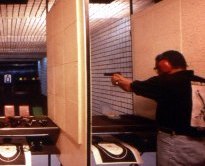 The
first time you walk onto the range with other shooters and live rounds,
there is an unavoidable feeling: each of us holds in our hands the
ability to kill the other. I must trust you. You must trust me, there is
no other way. The differences we see outside of this room - clothing
and lifestyle - are left outside.
The
first time you walk onto the range with other shooters and live rounds,
there is an unavoidable feeling: each of us holds in our hands the
ability to kill the other. I must trust you. You must trust me, there is
no other way. The differences we see outside of this room - clothing
and lifestyle - are left outside.
Firearm safety is rooted in a mutual
trust
of each other and
respect
for the gun. The safety "rules" are habits and behaviors through which
you and those around you communicate that trust and respect.

|
|
|
As we've said before, a firearm is a tool just like a power tool or car and all are dangerous if mishandled. You should not operate a firearm solo until you’ve received instructions on safe handling and fired under supervision.
Fundamentals of Handling
1. Treat every firearm as if it is loaded.
You can't
know
if a gun is loaded just by looking at it. You have to open the action and check the magazine. Always hand off and receive a gun with the action open.
2. Always keep the gun pointed in a safe direction.
Keep the muzzle pointed away from others so that if the gun did discharge it would not cause injury or damage. Put another way, never point you run at something you don't intend to kill.
3. Keep you finger off the trigger until you're ready to shoot.
A safety is just a mechanical device which can fail, so don't take chances. Rest you finger on the body of the gun, not the trigger.
Fundamentals of Storage
Proper storage is not just for you. It is also for the safety of the other people around the gun who are not as familiar with its safe operation. Over half of all shooting accidents happen in the home. Always transport and store firearms
unloaded
and
locked
keeping
guns and ammunition separate.
Guns can be locked in a cabinet or individually using cable or trigger locks. Gun cabinets can be decorative made of wood and glass, or made of steel and double as a home safe and fire box. You'll also find many specialty storage boxes for ammunition - some painted camouflage, some that double as rifle supports, etc. - but for the cost conscious, a sturdy tool box and a lock should work fine for a lot less money.
Click photos to enlarge.


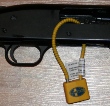

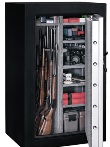
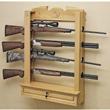

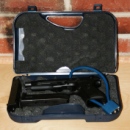
If you feel you must store an armed gun in your home for personal protection reasons, there are storage cases designed for quick access for this purpose. These include combination locks and biometric locks - which will open only to your hand. If these are beyond your family budget, then further condiserations of how to safely secure the firearm our of sight and out of reach of others are needed.
Fundamentals of Usage
1. Keep the gun unloaded until ready to use.
2. Know hot to use the gun safely.
Before loading any gun, know the basic parts, how to operate the action, load and unload the magazine, how to empty the chamber and how the safety works.
3. Know your target, and beyond.
Although the effective range of many guns is less than 100 yards, under ideal conditions, the bullets fired from modern firearms can travel.
(Click graphics to enlarge.)



 4. Be sure your gun is clean and safe to operate.
Maintenance and cleaning are crucial to keeping your gun working properly. Without proper cleaning, you run the risk of unfired cartridges jamming in the action or fired bullets jamming in the barrel - both of which are dangerous situations. Clean a gun after each use. When a gun has been in storage for an extended period of time, clean it before use to remove any built up dirt, grease or moisture.
4. Be sure your gun is clean and safe to operate.
Maintenance and cleaning are crucial to keeping your gun working properly. Without proper cleaning, you run the risk of unfired cartridges jamming in the action or fired bullets jamming in the barrel - both of which are dangerous situations. Clean a gun after each use. When a gun has been in storage for an extended period of time, clean it before use to remove any built up dirt, grease or moisture.
5. Only use the right ammunition for your gun.
A 20-gauge shell can be fired in a 12-gauge shotgun but the shell may jam in the barrel causing the next round to explode in your face. Check for stamps on the barrel, the cartridge and packaging. If in doubt, bring the gun to your local shop.
6. Wear proper ear and eye protection.
Firing a gun is loud and can cause permanent hearing damage. Always wear hearing protection when firing at an indoor range or firing large rifles or shotguns, even outdoors. Eye protection is needed for emissions of gas, debris and empty cartridges.
7. No drugs, no drinking when handling or using a firearm.
Links to more resources:
NRA Gun Safety Rules
NRA Eddie Eagle Program
Remington 10 Commandments of Firearm Safety
|
 Picture
yourself walking alone on a city street. Halfway down the
block, a group of guys that looks like trouble turns the corner toward
you. They are carrying various assault rifles, hand guns and shotguns.
How do you feel?
Picture
yourself walking alone on a city street. Halfway down the
block, a group of guys that looks like trouble turns the corner toward
you. They are carrying various assault rifles, hand guns and shotguns.
How do you feel?
 The
first time you walk onto the range with other shooters and live rounds,
there is an unavoidable feeling: each of us holds in our hands the
ability to kill the other. I must trust you. You must trust me, there is
no other way. The differences we see outside of this room - clothing
and lifestyle - are left outside.
The
first time you walk onto the range with other shooters and live rounds,
there is an unavoidable feeling: each of us holds in our hands the
ability to kill the other. I must trust you. You must trust me, there is
no other way. The differences we see outside of this room - clothing
and lifestyle - are left outside.














 4. Be sure your gun is clean and safe to operate.
Maintenance and cleaning are crucial to keeping your gun working properly. Without proper cleaning, you run the risk of unfired cartridges jamming in the action or fired bullets jamming in the barrel - both of which are dangerous situations. Clean a gun after each use. When a gun has been in storage for an extended period of time, clean it before use to remove any built up dirt, grease or moisture.
4. Be sure your gun is clean and safe to operate.
Maintenance and cleaning are crucial to keeping your gun working properly. Without proper cleaning, you run the risk of unfired cartridges jamming in the action or fired bullets jamming in the barrel - both of which are dangerous situations. Clean a gun after each use. When a gun has been in storage for an extended period of time, clean it before use to remove any built up dirt, grease or moisture.
